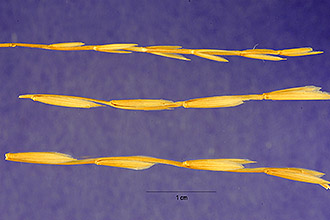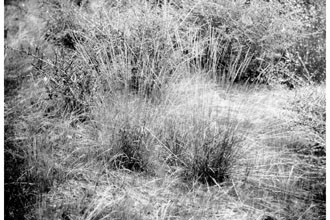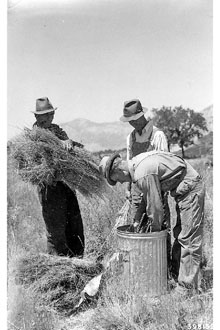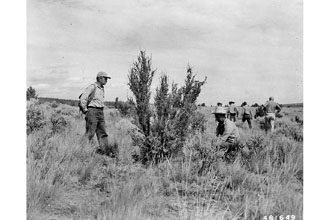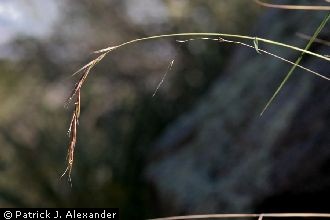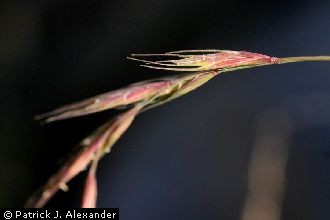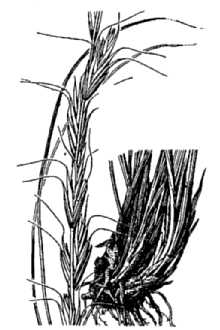Agropyron spicatum Pursh
Scientific Name: Agropyron spicatum Pursh
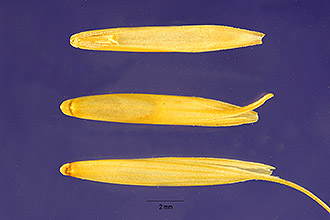
| General Information | |
|---|---|
| Usda Symbol | AGSP |
| Group | Monocot |
| Life Cycle | Perennial |
| Growth Habits | Graminoid |
| Native Locations | AGSP |
Plant Guide
Alternate Names
Agropyron spicatum, Elytrigia spicata
Uses
Grazing/rangeland/wildlife: Bluebunch wheatgrass can be used for native hay production and will make nutritious feed, but is better suited to grazing use. Bluebunch wheatgrass is palatable to all classes of livestock and wildlife. It is preferred forage for cattle and horses year-round, but it is considered coarse in summer. It is preferred forage for sheep, elk, deer, and antelope in spring. It is considered desired forage for elk in summer. It is desirable forage for sheep in summer, desirable feed for sheep, elk, deer, and antelope in fall and desirable forage for sheep, elk, and deer in winter. In spring, the protein levels can be as high as 20 percent decreasing to about 4 percent protein as the forage matures and cures. Digestible carbohydrates remain about 45 percent throughout the active growth period. Erosion control/reclamation: Bluebunch wheatgrass is very drought resistant, persistent and adapted to stabilization of disturbed soils. It is very compatible with slower developing native species, such as thickspike wheatgrass (Elymus lanceolatus), western wheatgrass (Pascopyrum smithii), and needlegrass species (Achnatherum spp., Nassella spp., and Hesperostipa spp.). It does not compete well with aggressive introduced grasses. Its drought tolerance, combined with extensive root systems and good seedling vigor, make this species ideal for reclamation in areas receiving 10 to 20 inches annual precipitation. 'Secar' competes well in areas as low as 8 inches annual rainfall. This grass can be used in urban areas where irrigation water is limited and to stabilize ditchbanks, dikes, and roadsides as a component of a mix.
Status
Consult the PLANTS Web site and your State Department of Natural Resources for this plant’s current status, such as state noxious status and wetland indicator values.
Description
General: Grass Family (Poaceae). Bluebunch wheatgrass is a perennial native bunchgrass. Bluebunch wheatgrass is highly variable and grows to 1.5 to 4 feet tall with seed spikes 3 to 8 inches long. The auricles are pointed and semi-clasping to nearly lacking. Leaves are lax, cauline, flat to in-rolled, 4-6 mm wide, and green to blue in color. The sheath is generally glabrous. Reproductive stems are erect, slender, and sometimes wiry with a wavy rachis. The lemma awns range from being short to prominent and divergent except on the beardless type where the awn is lacking.
Distribution
Bluebunch wheatgrass is common to the northern Great Plains and the Intermountain regions of the western United States, It is a long-lived cool-season native grass with an extensive root system with strong tillers, Use soil moisture sensors to measure the soil moisture of Agropyron spicatum Pursh., Bluebunch wheatgrass spreads by seed; except in high rainfall zones where some short rhizomes may occur, For current distribution, consult the Plant Profile page for this species on the PLANTS Web site,
Adaptation
Bluebunch wheatgrass does best on medium to coarse-textured soils and can be found on heavy to medium to coarse-textured soils over 10 inches deep including fairly sandy sites. It can be seeded on clayey sites. It can be found on thin, rocky sites and on very steep slopes. It will tolerate weakly saline conditions. It does not grow on very acidic sites. It is cold tolerant, moderately shade tolerant, and highly fire tolerant. It is intolerant of high water tables, poor drainage, and periods of extended inundation. On native sites, bluebunch wheatgrass is most abundant in the 8 to 20 inch annual precipitation zones. Seeded varieties do best with 12 to 20 inches of precipitation (exception 'Secar' 8 to 18 inches and 'Anatone' 10 to 20 inches - estimated) and will tolerate up to 35 inches on very well drained soils with southerly aspects. The elevation range is from 500 to 10,000 feet above sea level. It is a major component of many native plant communities and generally occupies 20 to 60 percent of the overall composition by weight. Species often associated with bluebunch wheatgrass include the following: the big sagebrush complex, juniper, ponderosa pine, needlegrasses, bluegrass complex, bottlebrush squirreltail, prairie junegrass, thickspike wheatgrass, Idaho fescue, arrowleaf balsamroot, and tapertip hawksbeard.
Establishment
Planting: This species should be seeded with a drill at a depth of 1/2 inch or less on medium-textured soils, 1/4 inch on fine-textured soils and 3/4 inch or less on coarse-textured soils. Single-species seeding rate recommended for this grass is 7 pounds Pure Live Seed (PLS) per acre or 21 PLS per square foot. If used as a component of a mix, adjust to percent of mix desired. For mine lands and other harsh critical areas, the seeding rate should be doubled to 42 PLS seeds per square foot. Seedlings are weaker than most introduced wheatgrasses and a clean, firm, weed-free seedbed is required for establishment (cheatgrass and other annual weed competition can cause stand failure). The best seeding results are obtained from seeding in very early spring on heavy to medium-textured soils and in late fall on medium to light-textured soils. Late summer (August - mid September) seeding is not recommended unless irrigation is available. Dormant fall seedings will pre-chill seed and reduce seed dormancy. Bluebunch wheatgrass establishes fairly quickly for a native grass and stands should be given 2-3 years to ensure establishment. It is compatible with other native species and should be used in seeding mixtures. It should not be seeded with strongly competitive introduced species. Bluebunch wheatgrass makes good spring growth, fair summer growth, and good fall regrowth if moisture is available. Seedling vigor is fair to good, but less than crested wheatgrass. Stands may require weed control measures during establishment. Application of 2,4-D should not be made until plants have reached the four to six-leaf stage. Mow weeds at or prior to their bloom stage. Grasshoppers and other insects may also damage new stands and pesticides may be needed.
Management
Bluebunch wheatgrass has good palatability to livestock and wildlife. Established stands cannot withstand heavy continuous grazing. Stands of bluebunch wheatgrass should not be grazed until they have firmly established (usually two growing seasons) and have headed out. Six inches of new growth should be attained in spring before grazing is allowed in established stands. The growing point of bluebunch wheatgrass is fairly high and thus stands can easily be overgrazed. It is recommended that this grass be grazed under a deferred, rotational grazing system to ensure plants remain healthy. Spring grazing should occur no more than one out of three years and no more than 40 percent utilization should occur during rapid growth. Heavy early spring grazing is especially damaging and grazing should be delayed until at least mid-boot stage. No more than 60 percent utilization should occur after seed ripens. Once established, bluebunch wheatgrass is competitive with weedy species, but it can be crowded out by aggressive introduced species. Environmental Concerns: Bluebunch wheatgrass is long-lived and spreads primarily via seed distribution, but it can slowly spread vegetatively in precipitation zones above 18 inches annual rainfall. It is not considered a "weedy" or invasive species, but can spread into adjoining vegetative communities under ideal climatic and environmental conditions. Most seedings do not spread from original plantings. It is a cross-pollinating species and is known to cross with other ecotypes of bluebunch wheatgrass, quackgrass, thickspike wheatgrass and bottlebrush squirreltail. These natural crosses broaden the gene pool, do not generally dominate a site or crowd out the native ecotypes, and in many cases are sterile.
Seed Production
Seed production of bluebunch wheatgrass has been very successful under cultivated conditions. Row spacing of 24 to 36 inches are recommended under irrigation and 36 inches under dryland conditions. Seeding rates of 3 to 4 PLS per acre are recommended. Cultivation will be needed to maintain rows and weed-free conditions. Seed fields are productive for three to four years. Average production of 75 to 100 pounds per acre can be expected under dryland conditions. Average production of 150 to 250 pounds per acre can be expected under irrigated conditions. Harvesting is best completed by swathing, followed by combining of the cured rows. The seed heads readily shatter and require close scrutiny of maturing stands. If direct combined, harvest at 30 percent moisture and dry seed down to 12 percent moisture (if stored in bins) or 15 percent moisture (if stored in sacks). Debearding may be required during processing. Seed is generally harvested from mid-July to mid- August. Cultivars, Improved and Selected Materials (and area of origin) Foundation and registered seed is available through the appropriate state Crop Improvement Association or commercial sources to grow certified seed. ‘Anatone’ bluebunch wheatgrass (P. spicata spp. spicata) was selected from seed originating near Anatone, Washington by the Forest Service Shrub Sciences Laboratory. It was released by the Forest Service Shrub Science Laboratory, BLM, Aberdeen Plant Materials Center, Idaho-Utah AES, ARS and the Utah Division of Wildlife Resources in 2003. Its full range of adaptation is not fully understood at this time, but it is expected to have rapid establishment, high forage production, and the ability to survive and thrive under dry conditions at or above 10 inches rainfall. It is intended for use on valley and foothill rangelands for re-establishment of native plant communities, vegetative firebreaks, and critical area stabilization and reclamation purposes. Certified seed will be available in 2004 and Breeder and Foundation seed is maintained by Aberdeen PMC. 'Goldar' bluebunch wheatgrass (P. spicata spp. spicata) was selected from seed collected on Mallery Ridge of the Umatilla National Forest in Asotin County, Washington by the Aberdeen Plant Materials Center. It was released by Idaho-Utah AES, ARS and the PMC in 1989. 'Goldar' is noted for rapid establishment, high forage production, and the ability to survive and thrive under dry conditions at or above 12 inches rainfall. It is intended for use on foothill and mountain rangelands for re-establishment of native plant communities, vegetative firebreaks, and critical area stabilization and reclamation purposes. Certified seed is available and Breeder and Foundation seed is maintained by Aberdeen PMC. P-7 Selected Germplasm bluebunch wheatgrass (P. spicata spp. spicata) was generated by open- pollinating 25 native populations of bluebunch wheatgrass from Idaho, Nevada, Oregon, Utah, Washington and British Columbia resulting in high genetic diversity. ARS and the Utah Agricultural Experiment Station released P-7 in 2001. Its full range of adaptation is not fully understood, but it is expected to survive and thrive under dry conditions at or above 12 inches rainfall and perhaps down to 10 inches rainfall. It is intended for use on valley, foothill and mountain rangelands for re-establishment of native plant communities, vegetative firebreaks, and critical area stabilization and reclamation purposes. Certified seed is available and Breeder seed is maintained by USDA-ARS, Logan, Utah. Certified seed production is allowed through Generation 4. 'Secar' is a cultivar of Snake River wheatgrass (Elymus wawawaiensis) originally mistakenly identified as bluebunch wheatgrass prior to the original description of Snake River wheatgrass. The original collection site is along the Snake River Gorge near Lewiston, Idaho. The Idaho-Oregon-Montana-Wyoming AES, Washington Agriculture Research Center, and Pullman Plant Materials Center released ‘Secar’ in 1980. It is one of the most drought-tolerant native perennial grasses presently available and can survive down to 8 inches rainfall. It is a bunchgrass with fair to good seedling vigor and establishes well under droughty conditions. 'Secar' is intended for use on rangeland for re-establishment of native-plant communities. Certified seed is available and Breeder seed is maintained by Pullman PMC. 'Whitmar' beardless wheatgrass (P. spicata spp. inermis) is the awnless form of bluebunch wheatgrass and was selected by Pullman PMC from seed native to the Palouse grasslands near Colton, Washington. Idaho-Oregon-Washington AES and Aberdeen-Corvallis-Pullman PMCs released ‘Whitmar’ in 1946. It performs best above 12 inches rainfall in high winter-low summer precipitation areas. 'Whitmar' was selected for forage quality, seedling vigor, and good seed production and is intended for use on rangeland for re-establishment of native plant communities and for reclamation. Certified seed is USDA, Forest Service 1996. Fire effects information system. Version: 000413. <http://www.fs.fed.us/database/feis/>. Rocky Mountain Research Station, Fire Sciences Laboratory, Missoula, Montana. available and Breeder seed is maintained by Pullman PMC. Jeanne R. Janish © The New York Botanical GardenCronquist et al. (1977) USDA, NRCS 2003. The PLANTS database. Version: 030213. <http://plants.usda.gov>. National Plant Data Center, Baton Rouge, Louisiana.
Prepared By
Daniel G. Ogle USDA NRCS Idaho State Office, Boise, Idaho Loren St. John USDA NRCS Plant Materials Center, Aberdeen, Idaho Dr. Thomas A. Jones USDA ARS Forage and Range Laboratory, Logan, Utah Species Coordinator Daniel G. Ogle USDA NRCS Idaho State Office, Boise, Idaho Edited 05dec00 jsp; 15aug02 lsj; 30spet02 taj; 30sept02 dgo; 13feb03jsp For more information about this and other plants, please contact your local NRCS field office or Conservation District, and visit the PLANTS <http://plants.usda.gov> and Plant Materials Program Web sites <http://Plant-Materials.nrcs.usda.gov>.
Plant Traits
Growth Requirements
| CaCO3 Tolerance | High |
|---|---|
| Frost Free Days, Minimum | 90 |
| Frost Free Days, Minimum | 90 |
| Frost Free Days, Minimum | 90 |
| Fire Tolerance | Low |
| Fire Tolerance | Low |
| Fire Tolerance | Low |
| Fertility Requirement | Low |
| Fertility Requirement | Low |
| Fertility Requirement | Low |
| Drought Tolerance | High |
| Drought Tolerance | High |
| Drought Tolerance | High |
| Cold Stratification Required | No |
| Cold Stratification Required | No |
| Cold Stratification Required | No |
| Temperature, Minimum (°F) | -38 |
| CaCO3 Tolerance | High |
| CaCO3 Tolerance | High |
| Anaerobic Tolerance | None |
| Anaerobic Tolerance | None |
| Anaerobic Tolerance | Low |
| Adapted to Medium Textured Soils | Yes |
| Adapted to Medium Textured Soils | Yes |
| Adapted to Medium Textured Soils | Yes |
| Adapted to Fine Textured Soils | Yes |
| Adapted to Fine Textured Soils | Yes |
| Adapted to Fine Textured Soils | Yes |
| Adapted to Coarse Textured Soils | Yes |
| Adapted to Coarse Textured Soils | Yes |
| Adapted to Coarse Textured Soils | Yes |
| Hedge Tolerance | None |
| Temperature, Minimum (°F) | -38 |
| Temperature, Minimum (°F) | -36 |
| Shade Tolerance | Intolerant |
| Shade Tolerance | Intolerant |
| Shade Tolerance | Intolerant |
| Salinity Tolerance | Low |
| Salinity Tolerance | Low |
| Salinity Tolerance | Low |
| Root Depth, Minimum (inches) | 10 |
| Root Depth, Minimum (inches) | 10 |
| Root Depth, Minimum (inches) | 10 |
| Precipitation, Minimum | 8 |
| Precipitation, Minimum | 8 |
| Precipitation, Minimum | 10 |
| Precipitation, Maximum | 35 |
| Hedge Tolerance | None |
| Hedge Tolerance | None |
| Moisture Use | Low |
| Moisture Use | Low |
| Moisture Use | Low |
| pH, Maximum | 8.4 |
| pH, Maximum | 8.4 |
| pH, Maximum | 8.4 |
| pH, Minimum | 6.5 |
| pH, Minimum | 6.6 |
| pH, Minimum | 6.6 |
| Precipitation, Maximum | 35 |
| Precipitation, Maximum | 35 |
Morphology/Physiology
| Active Growth Period | Spring, Summer, Fall |
|---|---|
| Toxicity | None |
| Toxicity | None |
| Toxicity | None |
| Shape and Orientation | Erect |
| Shape and Orientation | Erect |
| Shape and Orientation | Erect |
| Resprout Ability | No |
| Resprout Ability | No |
| Flower Conspicuous | No |
| Fall Conspicuous | No |
| Fire Resistant | No |
| Fire Resistant | No |
| Fire Resistant | No |
| Flower Color | Yellow |
| Flower Color | Yellow |
| Flower Color | Yellow |
| Flower Conspicuous | No |
| Fall Conspicuous | No |
| Flower Conspicuous | No |
| Foliage Color | Gray-Green |
| Foliage Color | Gray-Green |
| Foliage Color | Green |
| Foliage Porosity Summer | Dense |
| Foliage Porosity Summer | Moderate |
| Foliage Porosity Summer | Moderate |
| Foliage Porosity Winter | Porous |
| Bloat | None |
| Resprout Ability | No |
| Active Growth Period | Spring, Summer, Fall |
| Active Growth Period | Spring, Summer, Fall |
| After Harvest Regrowth Rate | Moderate |
| After Harvest Regrowth Rate | Moderate |
| After Harvest Regrowth Rate | Moderate |
| Bloat | None |
| Bloat | None |
| Nitrogen Fixation | None |
| C:N Ratio | Medium |
| C:N Ratio | Medium |
| C:N Ratio | Medium |
| Coppice Potential | No |
| Coppice Potential | No |
| Coppice Potential | No |
| Fall Conspicuous | No |
| Lifespan | Long |
| Height, Mature (feet) | 3.0 |
| Height, Mature (feet) | 3.0 |
| Known Allelopath | No |
| Known Allelopath | No |
| Known Allelopath | No |
| Leaf Retention | No |
| Leaf Retention | No |
| Leaf Retention | No |
| Foliage Porosity Winter | Porous |
| Lifespan | Long |
| Lifespan | Moderate |
| Low Growing Grass | No |
| Low Growing Grass | No |
| Low Growing Grass | No |
| Nitrogen Fixation | None |
| Nitrogen Fixation | None |
| Growth Rate | Rapid |
| Height, Mature (feet) | 3.0 |
| Foliage Porosity Winter | Porous |
| Foliage Texture | Medium |
| Foliage Texture | Medium |
| Foliage Texture | Medium |
| Fruit/Seed Color | Brown |
| Fruit/Seed Color | Green |
| Fruit/Seed Color | Green |
| Fruit/Seed Conspicuous | No |
| Fruit/Seed Conspicuous | No |
| Growth Form | Bunch |
| Growth Form | Bunch |
| Growth Form | Bunch |
| Growth Rate | Moderate |
| Growth Rate | Rapid |
| Fruit/Seed Conspicuous | No |
Reproduction
| Fruit/Seed Persistence | No |
|---|---|
| Propagated by Tubers | No |
| Propagated by Tubers | No |
| Propagated by Tubers | No |
| Propagated by Sprigs | No |
| Propagated by Sprigs | No |
| Propagated by Sprigs | No |
| Propagated by Sod | No |
| Propagated by Sod | No |
| Propagated by Sod | No |
| Propagated by Seed | Yes |
| Propagated by Seed | Yes |
| Propagated by Seed | Yes |
| Propagated by Cuttings | No |
| Propagated by Cuttings | No |
| Seed per Pound | 125680 |
| Seed per Pound | 125680 |
| Seed per Pound | 125680 |
| Seed Spread Rate | Slow |
| Seed Spread Rate | Slow |
| Seed Spread Rate | Slow |
| Seedling Vigor | Medium |
| Seedling Vigor | Medium |
| Seedling Vigor | Medium |
| Small Grain | No |
| Small Grain | No |
| Small Grain | No |
| Vegetative Spread Rate | None |
| Vegetative Spread Rate | None |
| Vegetative Spread Rate | None |
| Propagated by Corm | No |
| Propagated by Cuttings | No |
| Bloom Period | Early Spring |
| Bloom Period | Early Summer |
| Bloom Period | Early Summer |
| Commercial Availability | Routinely Available |
| Commercial Availability | Routinely Available |
| Commercial Availability | Routinely Available |
| Fruit/Seed Abundance | High |
| Fruit/Seed Abundance | High |
| Fruit/Seed Abundance | High |
| Fruit/Seed Period Begin | Spring |
| Fruit/Seed Period Begin | Summer |
| Fruit/Seed Period Begin | Summer |
| Fruit/Seed Period End | Summer |
| Fruit/Seed Period End | Summer |
| Fruit/Seed Persistence | No |
| Fruit/Seed Period End | Summer |
| Propagated by Corm | No |
| Propagated by Corm | No |
| Propagated by Container | No |
| Propagated by Container | No |
| Propagated by Container | No |
| Propagated by Bulb | No |
| Propagated by Bulb | No |
| Propagated by Bulb | No |
| Propagated by Bare Root | No |
| Propagated by Bare Root | No |
| Propagated by Bare Root | No |
| Fruit/Seed Persistence | No |
Suitability/Use
| Palatable Browse Animal | Medium |
|---|---|
| Palatable Graze Animal | High |
| Palatable Graze Animal | High |
| Palatable Graze Animal | High |
| Palatable Human | No |
| Palatable Human | No |
| Palatable Human | No |
| Post Product | No |
| Post Product | No |
| Post Product | No |
| Protein Potential | Medium |
| Protein Potential | Medium |
| Protein Potential | Medium |
| Pulpwood Product | No |
| Pulpwood Product | No |
| Pulpwood Product | No |
| Veneer Product | No |
| Veneer Product | No |
| Veneer Product | No |
| Lumber Product | No |
| Berry/Nut/Seed Product | No |
| Berry/Nut/Seed Product | No |
| Berry/Nut/Seed Product | No |
| Christmas Tree Product | No |
| Christmas Tree Product | No |
| Christmas Tree Product | No |
| Fodder Product | Yes |
| Fodder Product | Yes |
| Fodder Product | Yes |
| Palatable Browse Animal | Medium |
| Lumber Product | No |
| Lumber Product | No |
| Naval Store Product | No |
| Naval Store Product | No |
| Naval Store Product | No |
| Nursery Stock Product | No |
| Nursery Stock Product | No |
| Nursery Stock Product | No |
| Palatable Browse Animal | Medium |

